
Custom T-Shirts & Apparel 25% Discount & Free Shipping
Know Your Price Immediately!
No more coupon codes necessary for Super online pricing. TerrificT just made it a little easier to know what you are paying. All you have to do is click on the product to see your discounted price. Shipping is Free on every...






